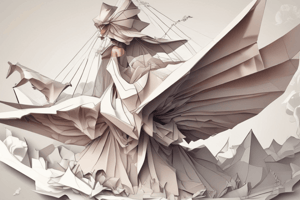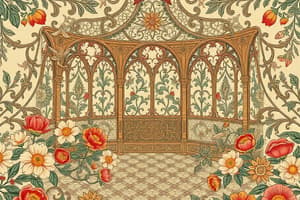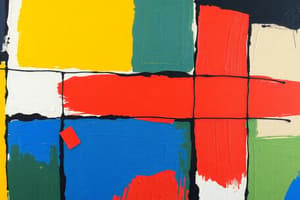Podcast
Questions and Answers
What distinguishes three-dimensional art from two-dimensional art?
What distinguishes three-dimensional art from two-dimensional art?
- It relies solely on the use of lines.
- It involves only color application without depth.
- It is created using a flat surface.
- It includes actual depth and can be viewed from multiple angles. (correct)
What is the most important element in two-dimensional drawings?
What is the most important element in two-dimensional drawings?
- Color
- Shape
- Line (correct)
- Texture
What is a characteristic of oil-based paints?
What is a characteristic of oil-based paints?
- They dry slowly, permitting the blending of colors on the canvas. (correct)
- They require hazardous solvents for application.
- They dry quickly allowing for immediate color blending.
- They are primarily water-based.
Which of the following is NOT a characteristic of two-dimensional media?
Which of the following is NOT a characteristic of two-dimensional media?
Which material is commonly used in crafts as a type of three-dimensional art?
Which material is commonly used in crafts as a type of three-dimensional art?
What is the primary purpose of three-dimensional art besides aesthetics?
What is the primary purpose of three-dimensional art besides aesthetics?
Which painting method allows artists to use their hands or fingers to create shapes?
Which painting method allows artists to use their hands or fingers to create shapes?
What do you call the process of creating a three-dimensional art piece from materials like wood or metal?
What do you call the process of creating a three-dimensional art piece from materials like wood or metal?
What defines free-standing sculpture?
What defines free-standing sculpture?
Which sculpting method involves removing material to create a form?
Which sculpting method involves removing material to create a form?
What materials can be used in the assembling process of sculpture?
What materials can be used in the assembling process of sculpture?
What is the core purpose of crafts mentioned in the content?
What is the core purpose of crafts mentioned in the content?
What role does architecture play according to the content?
What role does architecture play according to the content?
Which of the following is NOT a characteristic of casting in sculpting?
Which of the following is NOT a characteristic of casting in sculpting?
Which of the following is an example of a craft mentioned in the content?
Which of the following is an example of a craft mentioned in the content?
How have technological advances influenced the arts?
How have technological advances influenced the arts?
What is the primary function of photography as described?
What is the primary function of photography as described?
Which device is regarded as the first camera in history?
Which device is regarded as the first camera in history?
What do projective techniques in psychology primarily assess?
What do projective techniques in psychology primarily assess?
What is iconography used for in the context of art?
What is iconography used for in the context of art?
What is a key tool in computer arts for graphic designers?
What is a key tool in computer arts for graphic designers?
What messages do artworks convey as mentioned in the content?
What messages do artworks convey as mentioned in the content?
What technique involves drawing a house, tree, and person for psychological analysis?
What technique involves drawing a house, tree, and person for psychological analysis?
What aspect of art does the criticism of arts and judgment of aesthetic highlight?
What aspect of art does the criticism of arts and judgment of aesthetic highlight?
What does the 'subject' of an artwork mainly address?
What does the 'subject' of an artwork mainly address?
Why is understanding the criteria for judging artwork important?
Why is understanding the criteria for judging artwork important?
What component of art answers the 'how' in the creation process?
What component of art answers the 'how' in the creation process?
Which of the following is NOT a type of subject in visual arts?
Which of the following is NOT a type of subject in visual arts?
What aspect does 'content' in artwork address?
What aspect does 'content' in artwork address?
In terms of categorizing artwork, which of the following components can be analyzed?
In terms of categorizing artwork, which of the following components can be analyzed?
What best describes representational subjects in art?
What best describes representational subjects in art?
What role does the form of an artwork play in its creation?
What role does the form of an artwork play in its creation?
What role does abstraction play in the creative process of artists?
What role does abstraction play in the creative process of artists?
Which source of artistic inspiration is most related to emotions in art?
Which source of artistic inspiration is most related to emotions in art?
How have myths and legends influenced art historically?
How have myths and legends influenced art historically?
In what context do ideas commissioned by employers typically apply?
In what context do ideas commissioned by employers typically apply?
What is the primary focus of mimetic art?
What is the primary focus of mimetic art?
Which type of art is most likely to express satirical views of world events?
Which type of art is most likely to express satirical views of world events?
Which source of artistic inspiration is specifically tied to personal or cultural beliefs?
Which source of artistic inspiration is specifically tied to personal or cultural beliefs?
What is a common artistic subject from the natural world?
What is a common artistic subject from the natural world?
Flashcards are hidden until you start studying
Study Notes
Art Appreciation
- Form in Art: Refers to the arrangement and structure of an artwork; categorized into the final output (2D or 3D) and the creative process.
Two-Dimensional Art
- Two-Dimensional Media: Comprises art forms like drawings and paintings produced on flat surfaces without real depth.
Drawings
- Defined as moving an instrument over a surface to create marks, primarily through lines; sketches often precede other artwork.
Paintings
- Involves applying colors to surfaces using brushes, knives, or even hands; can utilize oil-based or water-based paints.
- Oil-based: Slower drying allows easier color blending.
- Water-based: Generally dries quicker than oil paints.
Three-Dimensional Art
- Has actual depth, allowing viewers to perceive it from multiple angles, enhancing physical impact.
Three-Dimensional Media
-
Sculpture: Made from materials like clay, glass, and metal. Types include:
- Free-standing: Can be viewed from all sides.
- Relief: Attached to a flat surface, providing limited viewing angles.
-
Assembling: Combining different materials to create a sculpture.
-
Modeling: Gradually adding material to build form.
-
Carving: Subtractive process where material is removed to create shapes.
-
Casting: Using pliable materials shaped with manual or machine force.
-
Crafts: Functional objects like baskets or pottery, often with utilitarian purposes.
-
Architecture: Involves planning and constructing safe spaces, including buildings and monuments.
Technological Media
- Technology has made artistic creation more accessible, exemplified by:
- Photography: Capturing images using light-sensitive cameras, starting with the daguerreotype in the 19th century.
- Films and Videos: Transitioning from still pictures to moving images, accessible via smartphones today.
Content in Art
- Refers to emotional or intellectual messages conveyed through artworks, exploring the artist's intentions and context.
Iconography
- Technique for understanding deeper meanings in art elements and symbols, revealing thoughts and emotions.
Artistic Assessment
- Art can serve as a tool for psychological assessment; methods include projective techniques like the House-Tree-Person Test and Rorschach Inkblot Test.
Criticism of Arts
- Requires a systematic approach and criteria to evaluate and appreciate art effectively, enhancing personal connection with the artist's narrative.
Components of Art: Subject, Form, and Content
-
Subject: What the artwork depicts (topic, image).
- Types:
- Representational: Clearly recognizable subjects.
- Non-representational: Abstract or distorted representations.
- Types:
-
Form: How the artwork is created (development, composition).
-
Content: Why the artwork exists (artist's intent, emotions).
Sources of Artistic Inspiration
- Nature, people, world events, myths, legends, and spiritual beliefs can inspire artists in their creative processes.
- Commissioned work includes creating designs for corporate clients, brochures, and interior spaces.
Imitationalism
- A critical approach emphasizing the realistic representation in artwork.
Studying That Suits You
Use AI to generate personalized quizzes and flashcards to suit your learning preferences.




